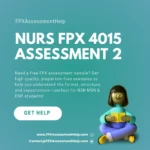NURS FPX 4905 Assessment 3 Technology and Professional Standards
Student Name
Capella University
NURS-FPX4905 Capstone Project for Nursing
Prof. Name
Date
Technology and Professional Standards
Technology and professional standards play a critical role in advancing quality, safety, and efficiency in healthcare delivery. In regenerative medicine, where diagnostic complexity is common, the integration of appropriate technologies and adherence to nursing standards are essential for timely and accurate care (Kantaros & Ganetsos, 2023). This paper explores the role of the BSN-prepared nurse in addressing diagnostic delays at The Longevity Center through process improvement and collaboration. It examines the current use of technology, evidence-based recommendations from regulatory agencies, and potential solutions for implementing new tools. Additionally, the paper outlines interprofessional strategies and discusses challenges and benefits associated with adopting advanced diagnostic technologies.
Role of the BSN-Prepared Nurse in Process Improvement and Professional Standards
At The Longevity Center, the BSN-prepared nurse will be critical in the maintenance of diagnostic accuracy and timely care by following the professional standards and engaging in the process improvement. The problem of late or irregular diagnosis needs an active nursing focus based on evidence-based practice, communication, and advocacy of the patient. Nurses play their role by making sure that clinical intake is comprehensive, blood panel interpretation is correct, and patient history is carefully scrutinized. This role also includes detecting the gaps in the diagnostic processes and suggesting the changes that do not contradict the principles of the American Nurses Association (ANA) Code of Ethics that focus on accountability and the enhancement of safe and effective care (American Nurses Association, 2025).
Another part of the process change is the identification of situations when patients are in need of more detailed evaluation or when new diagnostic tools could speed up the process of treatment. As an example, failure to interpret Longevity blood panels promptly or failure to chart consistently may lead to missing therapeutic opportunities. I have assisted the team in standardization of the collection of patient history and given observations in the review of cases. Interprofessional communication is another professional standard promoted in this position. I also guarantee continuity and quality of care by communicating clinical concerns to providers. My involvement in the process is valuable although I lack the authority to make change since I am a member of the team.
Interprofessional Collaboration in Regenerative Healthcare
Interprofessional collaboration at The Longevity Center plays a crucial role in enhancing diagnostic efficiency and patient outcomes in regenerative medicine. Collaboration primarily occurs between nurses, nurse practitioners, medical doctors, and administrative staff. During the practicum, I have participated in reviewing patient charts alongside the provider and contributing to case discussions, particularly when interpreting Longevity blood panels or assessing a patient’s readiness for treatments like PRP or stem cell injections. This form of collaboration ensures that each team member’s perspective contributes to a more holistic understanding of the patient’s condition.
Moving forward, greater interprofessional integration will be implemented by fostering more structured communication methods, such as interdisciplinary case huddles or shared digital platforms for care coordination. The goal is to create more consistent collaboration when determining diagnostics and customizing treatment plans. For instance, real-time updates between providers and nurses during intake and follow-up would help identify care gaps and ensure that delays in lab interpretation or miscommunication about treatment protocols are minimized (Kantaros & Ganetsos, 2023). The benefits of this collaboration are multifold. It promotes more accurate diagnoses, faster initiation of regenerative therapies, and improved patient satisfaction. Additionally, it supports safer and more effective care by reducing the chances of overlooked clinical data or fragmented communication between care providers.
Government Agency Recommendations
Several government and regulatory agencies provide guidance relevant to the diagnostic delays identified at The Longevity Center. The Joint Commission emphasizes the importance of accurate and timely diagnosis as a cornerstone of safe patient care. Their National Patient Safety Goals highlight the need for effective communication among caregivers and the implementation of standardized processes for collecting patient data (The Joint Commission, 2021). These principles directly apply to the challenges at the clinic, where the intake process lacks uniformity and patients often arrive without clear documentation or diagnostic clarity. The assumption underlying these recommendations is that consistent procedures and effective communication reduce errors, improve diagnostic accuracy, and enhance patient outcomes.
The Agency for Healthcare Research and Quality, while not directly covering many regenerative treatments, advocate for quality-focused care, data-driven decision-making, and patient safety. They recommend the adoption of clinical decision support tools and evidence-based protocols to minimize care variability. Their approach assumes that the integration of technology with standardized care models leads to more efficient and cost-effective healthcare delivery (Agency for Healthcare Research and Quality, 2024). Additionally, the National Database of Nursing Quality Indicators supports the importance of nursing roles in identifying delays and ensuring diagnostic precision. Indicators such as timely assessments, proper documentation, and collaborative care are emphasized (Montalvo, 2020). These agencies collectively assume that early intervention, accurate diagnosis, and coordinated teamwork are essential for improving healthcare quality and reducing adverse outcomes.
Current Technology Utilized
The major technologies that are employed to facilitate diagnostic procedures at The Longevity Center are ultrasound imaging, digital health records, and superior laboratory panels known as the Longevity blood panel. The usefulness of ultrasound machines is especially noted in the guidance of regenerative medicine procedures like PRP and stem cell injection procedures to be accurate and with less risk. Also, patient intake, diagnostic results, lab findings, and progress notes are recorded on the electronic health record (EHR) system (The Longevity Center, 2024). The Longevity blood panel is a broad diagnostic tool that evaluates the inflammation, hormone levels, micronutrient deficiency, and metabolic status and provides a comprehensive picture of the patient.
Although such technologies are available, a number of problems constrain their use. The EHR system is not integrated with external diagnostic platforms and thus, the staff is forced to manually enter the lab data and re-verify the external test results. This causes delays and also the chances of transcription errors. Also, no centralized clinical decision support tool exists to warn of abnormal results or direct evidence-based treatment pathways. Due to this, certain diagnostic opportunities are missed or postponed. Though the current technology allows a minimum level of effective care, there is no interoperability streamlined and clinical support tools that influence efficiency and continuity (Yamada et al., 2021). Enhancement of the integration and decision support functions would have the effect of improving early diagnosis, minimizing time lapse between diagnosis and treatment, and ensuring improved clinical results.
Literature-Based Technology Recommendations for Improving Diagnostic Delays
Current literature identifies several technologies that can address diagnostic delays in regenerative medicine. One of the most recommended is the Clinical Decision Support System (CDSS). Pros of CDSS include real-time alerts, automatic flagging of abnormal lab results, and evidence-based treatment suggestions integrated within the EHR. These features improve diagnostic speed and reduce human error. Cons include the need for customization, potential alert fatigue, and high initial implementation costs (Yamada et al., 2021).
Artificial Intelligence (AI)-assisted diagnostics is another emerging solution. Pros of AI include the ability to analyze large volumes of lab and imaging data quickly and detect patterns that may not be obvious to clinicians. This supports more accurate diagnoses, especially in complex cases. Cons involve high costs, potential data privacy concerns, and limited understanding or acceptance by healthcare staff (Nosrati & Nosrati, 2023).
Remote patient monitoring (RPM) devices are also supported in the literature. These tools track ongoing health metrics like glucose levels or inflammation markers. Pros of RPM include early detection of worsening symptoms and personalized care adjustments. Cons include patient adherence issues, technical glitches, and integration difficulties with existing EHR systems (Petrosyan et al., 2022). While these technologies offer substantial benefits, successful implementation requires staff training, funding, and careful integration with current workflows.
Potential Implementation Issues and Solutions for New Diagnostic Technologies
Implementing new diagnostic technologies such as CDSS, AI-assisted tools, and RPM at The Longevity Center may face several challenges. One major issue is cost, as many of these systems require substantial financial investment for software, hardware, and licensing. This can be particularly limiting in smaller clinics with limited budgets. Another challenge is staff resistance, especially if the team is unfamiliar with advanced digital tools or concerned about increased workload and learning curves (Nosrati & Nosrati, 2023). Data integration is also a significant issue.
The existing electronic health record (EHR) system may not be compatible with newer technologies, requiring upgrades or third-party integration, which could delay adoption. In addition, privacy and compliance concerns must be addressed, particularly with AI tools that rely on large data sets (Petrosyan et al., 2022). These issues can be mitigated through gradual implementation, staff training programs, pilot testing, and phased integration. Seeking grant funding or technology partnerships may also help offset initial costs and accelerate adoption while maintaining compliance with healthcare regulations.
Conclusion
Enhancing diagnostic efficiency at The Longevity Center requires BSN-prepared nurses to lead standardized intake and advocate for professional standards. Strengthened interprofessional collaboration will ensure timely data sharing and coordinated treatment planning. Integration of CDSS, AI diagnostic tools, and remote monitoring can reduce delays but demands careful planning, training, and budget allocation. Phased implementation with targeted staff education and pilot testing will facilitate successful adoption and improved patient outcomes.
References
Agency for Healthcare Research and Quality. (2024, November). Clinical decision support. https://www.ahrq.gov/cpi/about/otherwebsites/clinical-decision-support/index.html
American Nurses Association. (2025). Code of ethics for nurses. https://codeofethics.ana.org/home
NURS FPX 4905 Assessment 3 Technology and Professional Standards
Kantaros, A., & Ganetsos, T. (2023). From static to dynamic: Smart materials pioneering additive manufacturing in regenerative medicine. International Journal of Molecular Sciences, 24(21). https://doi.org/10.3390/ijms242115748
Montalvo, I. (2020). The National Database of Nursing Quality Indicators® (NDNQI®). https://ojin.nursingworld.org/MainMenuCategories/ANAMarketplace/ANAPeriodicals/OJIN/TableofContents/Volume122007/No3Sept07/NursingQualityIndicators.html
Nosrati, H., & Nosrati, M. (2023). Artificial intelligence in regenerative medicine: Applications and implications. Biomimetics, 8(5). https://doi.org/10.3390/biomimetics8050442
Petrosyan, A., Martins, P. N., Solez, K., Uygun, B. E., Gorantla, V. S., & Orlando, G. (2022). Regenerative medicine applications: An overview of clinical trials. Frontiers in Bioengineering and Biotechnology, 10. https://doi.org/10.3389/fbioe.2022.942750
The Joint Commission. (2021). Quick safety issue 52. https://www.jointcommission.org/resources/news-and-multimedia/newsletters/newsletters/quick-safety/quick-safety-issue-52-advancing-safety-with-closed-loop-communication-of-test-results/
NURS FPX 4905 Assessment 3 Technology and Professional Standards
The Longevity Center. (2024, September 11). The Longevity Center. https://www.thelcfl.com/
Yamada, S., Behfar, A., & Terzic, A. (2021). Regenerative medicine clinical readiness. Regenerative Medicine, 16(3), 309–322. https://doi.org/10.2217/rme-2020-0178





